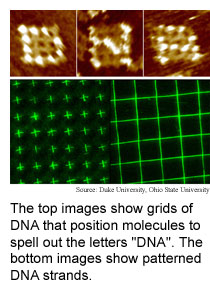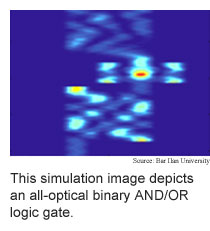
December
26, 2005/January 2, 2006
DNA
patterns
DNA is a versatile molecule with many potential technological
applications because it can organize itself into all manner of useful
patterns.
 Researchers from Duke University and the Korea Research Institute
of Standards and Science have expanded on their DNA grids by giving them
the ability to organize
other molecules. The DNA grids are made from DNA tiles, or combinations
of DNA strands that form rigid structures.
Researchers from Duke University and the Korea Research Institute
of Standards and Science have expanded on their DNA grids by giving them
the ability to organize
other molecules. The DNA grids are made from DNA tiles, or combinations
of DNA strands that form rigid structures.
The grids can incorporate different types of molecules at specific
points, including molecules that could be used to make electronic and
optical components. The grids are more than 60 times smaller than a red
blood cell and are part of an ongoing project to build computer chips
using DNA to assemble components such as carbon nanotubes into logic circuits.
The researchers made three types of patterned grids that spelled "D",
"N" and "A".
Meanwhile, Ohio State University researchers are using rubber
stamps that contain microscopic holes to stretch and organize DNA strands
into ordered
arrays such as grid patterns and crossed pairs of short strands. Key
to the method is the ability to control the size of a DNA strand.
Ordered arrays of DNA could be used to make bigger and cheaper
DNA chips. DNA chips are currently used for genetics research and medical
diagnosis. DNA grids and ordered arrays could eventually be used to make
smaller, faster and cheaper computer chips.
(Finite-Size, Fully Addressable DNA Tile Lattices Formed by Hierarchical
Assembly Procedures, Angewandte Chemie International Edition, published
online December 23, 2005; Generating Highly Ordered DNA Nano Strand Arrays,
Proceedings of the National Academy Of Sciences, December 20, 2005)
Optical circuits simplified
Computer circuits that use light to transmit information would
be much faster and would use less power than today's electronic circuitry.
There are a host of challenges in making practical optical circuits, however,
because light beams interact with each other only weakly.
 Getting light beams to affect each other typically requires high-power
light sources, long interaction times and special host materials. Researchers
from Bar Ilan University and Tel Aviv University in Israel have overcome
these problems with an optical
circuit design for microscopic light channels, or waveguides, that
contain highly reflective regions that force light beams to interfere
with each other.
Getting light beams to affect each other typically requires high-power
light sources, long interaction times and special host materials. Researchers
from Bar Ilan University and Tel Aviv University in Israel have overcome
these problems with an optical
circuit design for microscopic light channels, or waveguides, that
contain highly reflective regions that force light beams to interfere
with each other.
The researchers designed and simulated several types of typical
chip components using optical circuits: binary logic gates, an amplitude
modulator, and an analog adder/subtracter. These optical components are
the building blocks of optical memory chips, switches and analog-digital
converters.
Such optical circuits would be about the same size as existing
electronic circuits but would transmit information thousands of times
faster.
(Nano Photonic and Ultra Fast All-Optical Processing Modules,
Optics Express, December 12, 2005)
Nanotech medicine
Nanotechnology has the potential to improve medicine in many areas.
A pair of research developments move nanotechnology treatments for cancer
and degenerative eye problems closer to reality.
Researchers from Harvard Medical School and the University of
Connecticut have developed a cancer
treatment that uses nanoparticles to encapsulate light-sensitive molecules.
Nanoparticles are bits of matter not much bigger than molecules. When
a nanoparticles is absorbed by a cell it releases the encapsulated molecules.
Exposure to visible light makes the molecules toxic, killing the cells.
The nanoparticles completely eradicated several types of cancer tumors
in mice, according to the researchers.
Meanwhile, researchers from the University of Tokyo, Osaka Prefecture
University and Santen Pharmaceutical Co., Ltd. in Japan have developed
a macular
degeneration treatment for the form of the eye disease that is caused
by blood vessels growing under the retina.
The nanoscale treatment involves two types molecules -- one type
is light-sensitive and the other aggregates into nanoscale clumps. The
clumps accumulate on the menu blood vessels; when the clumps are exposed
to light they destroy the blood vessels.
(Polymeric Nanoparticle Preparation That Eradicates Tumors; Nanotechnology-Based
Photodynamic Therapy for Neovascular Disease Using a Supramolecular Nanocarrier
Loaded with a Dendritic Photosensitizer, Nano Letters, December
14, 2005)
Robotic consciousness
Although we are still a long way from artificial minds, researchers
from Meiji University in Japan have moved a step in that direction. They
have built a pair of robots that harbor rudimentary consciousnesses.
The first
robot, which is the size and shape of a small wastebasket, is able
to distinguish between a reflection of itself in a mirror and another
identical robot, and is able to imitate the other robot. The robot's neural
network enables the self-other recognition and imitative behavior.
The second
robot is a humanoid head and face that is capable of expressing human
emotions. The robot was fed a stream of information from the Internet,
and reacted to the information with facial emotions. These emotional reactions
identified, for instance, that fresh fish as good and rotting fish as
bad.
The work promises to help scientists understand human consciousness
and is a step toward giving robots the tools they need to better interact
with people.
(Conscious Robot That Distinguishes between Self and Others and
Implements Imitation Behavior, 18th International Conference on Industrial
and Engineering Applications of Artificial Intelligence and Expert Systems,
Bari, Italy, June 22-24, 2005; Expression of Emotion in Robots Using a
Flow of Artificial Consciousness, 6th IEEE International Symposium on
Computational Intelligence in Robotics and Automation, Espoo, Finland,
June 27-30, 2005)
Bits and pieces
An electronic camera reads all
of the bits at once in a quantum computer, providing a simple way
of reading out data in practical quantum computers; an artificial
cell component produces the biological fuel ATP; a nanostructured
electrode boosts dye-based solar cell performance to 8 percent, boosting
prospects for cheap solar cells; a nanomechanical
sensor distinguishes protein shapes; a two-dimensional DNA
scaffold assembles several types of nanoscale components into arrays
for making nanoscale devices; self-assembling micro-scale
cubes trap cells.
RSS Feeds: News Blog Books New: TRN's Internet Services TRN's Jobs Center News: Research News Roundup Research Watch blog Features: View from the High Ground Q&A How It Works Buy an ad link |
|
| Advertisements: |
|
Ad links: Clear History
Buy an ad link
|
TRN
Newswire and Headline Feeds for Web sites
|